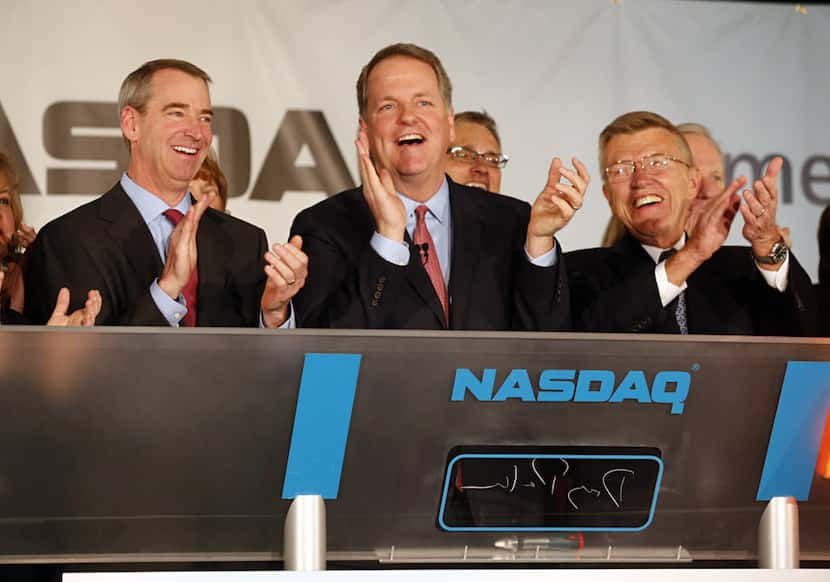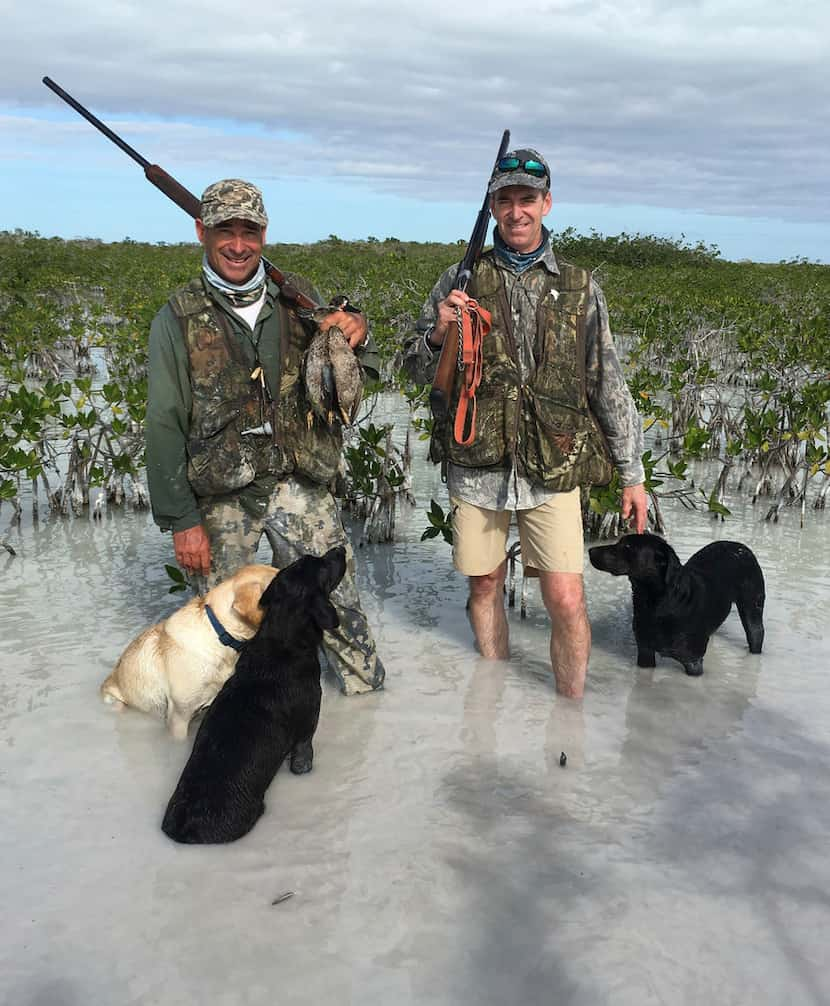Think Tom Horton flew into the business sunset after leaving American Airlines as its chairman nearly five years ago?
Think again.
The 57-year-old private investor is in demand as a corporate director — not just as “a” director, but as the lead director.
And Horton’s not just the lead director at any company.
Horton, who’s credited with heading one of the most successful major corporate restructurings ever, now serves as the trusted conduit between top management and the full board at three iconic U.S. corporations: Walmart Inc., Qualcomm Inc. and, most recently, General Electric Co.
Horton gives a shrug when asked whether he made about $600,000 in cash and stock last year from those board posts, an amount loosely calculated from the companies’ proxy materials.
That sounds about right, but he’s not doing it for the money, he says.
And with a $17 million goodbye kiss for his efforts at American, he doesn’t have to.
So why does he do it? “Because these three companies matter a lot to the country,” Horton says.
This patriotic calling is real, says Steve Mollenkopf, CEO of Qualcomm, which invented the next-generation 5G chipset that will be used in the internet of things — i.e., smart vehicles and appliances. “Tom’s like the last Boy Scout. He’s a solid citizen. It’s hard to come up with higher praise than that.”
Horton is both quietly confident and self-effacing about being the consensus choice for these lead roles.
“I always joke that you get to be a lead director because you happened to be out of the room when all of the other directors decided who the lead director would be,” Horton says. “I don’t know exactly what I bring to the table other than I’ve been around, and I’ve seen a lot.”
Indeed he has.

Alone in the dark
On Sunday, Nov. 27, 2011, Horton was elected CEO of both AMR Corp. and American Airlines in a late-night board conference call that lasted all of five minutes.
The next day, Horton would place the parent corporation under Chapter 11 protection.
Sitting alone in his Fort Worth headquarters office, Horton looked out into the darkness and saw his reflection in the windowpane.
He wondered what had just happened.
“I’m thinking, ‘I started my career with American, and on the day I become the CEO, my first act is to launch a bankruptcy restructuring,’” recalls Horton, who was 50 at the time.
Thoughts of the thousands of people counting on him weighed heavily on his mind. Yet he was confident that he and his team could pull it off.
For the next two years, Horton piloted AMR through a reinvention that included the carrier’s complete rebranding, the rejuvenation of its fleet and the turbulent merger with Phoenix-based US Airways Group that formed American Airlines Group Inc., the world’s largest airline.
“I was amazed at Tom’s ability to keep everything together, given the incredible circumstances that he had to deal with,” says Declan Kelly, founder and CEO of Teneo, a global C-suite advisory firm based in Manhattan. “He’s calmness personified. If you want somebody in the trenches when really important things are happening, he’s the guy you want.”
Horton’s soft-spoken, nice-guy persona belies his tenacity, says Kelly, who advises literally hundreds of Fortune 500 CEOs. “When Tom needs to put the hammer down and get things done, he’s not afraid to make the hard call.”
After US Airways' Doug Parker was chosen CEO of the combined company, Horton stayed on as chairman for four months to smooth the transition.
Then, on June 4, 2014, Horton chaired his final board meeting and left the headquarters building.
He hasn’t been back inside since.
Horton also hasn’t granted a personal interview since the one we had exactly six years ago as he turned over the CEO job to Parker.
People assumed Horton was disappointed that Parker was chosen to be CEO.
That’s an assumption Horton didn’t talk about back then, and he’s not about to open up about it now.
Typical Horton, says Kelly.
“You saw how he stepped away from American,” says Kelly. “There’s been nothing written about Tom since then. That’s a measure of the fact that the guy doesn’t just keep a low profile; he doesn’t want it to be about him.”

A really busy guy
Horton seems perfectly content with the way things turned out.
In addition to his big three boards, Horton spends about half of his time as a senior adviser for Warburg Pincus LLC, a global private equity firm focusing on growth investing. He’s on the executive board of the Cox School of Business of Southern Methodist University, where he earned his MBA, and is a member of the board of the National Air and Space Museum.
Susan Shaver, his longtime gatekeeper, says her boss has decompressed from his pressure-cooker days at American while still keeping a robust schedule.
Horton’s 16th-floor Uptown office suite looks down on Klyde Warren Park and provides a panoramic view of Woodall Rodgers Freeway.
His work sanctum is a tribute to his personal passions, with family pictures, aviation memorabilia, photos of him game fishing and bird hunting and shots of his two beloved dogs. There’s Tango, a sleek black Lab, and Pico, a scruffy border collie mix who attached herself to Horton during a fishing trip to Argentina last year with Gerard Arpey, Horton’s longtime buddy and fellow former American CEO.
Horton brought the stray home in the cargo hold. He hadn’t told Janet, his wife of 35 years, about his extra baggage.
“I was quite surprised by the new puppy — shocked might be a better word — as it was the first time Tom had done something like that,” she says. “He is not allowed to bring back any more animals from fishing trips without permission.”

Walmart and a newbie
Horton joined Walmart’s board in late 2014, a few months after exiting American. About the same time, he joined the board of Houston-based ForeFlight, a privately held startup that’s become an aviation sensation with its flight planning app.
“The big airlines are rolling it out,” says Horton. “It’s basically a flight bag on an iPad — charts, maps, georeference, weather. You could fly your plane even if you lost all of your instruments and had this iPad and a device that talks to the FAA and the towers on the ground.
“It has synthetic vision, so it gives you pitch, roll altitude, air speed, everything on your iPad.
"It’s a fascinating little company.”
Horton uses the app whenever he flies various private aircraft. That’s one reason he decided to join its board.
Horton loves the juxtaposition of serving on its board and Walmart’s.
The 100-plus-employee software company is a risk-taker and fleet of foot. The world’s largest company by revenue and this country’s largest private employer is striving hard to be more so.
Being controlled by Sam Walton’s heirs allows a longer-term view, Horton says, and you gotta love a company where Greg Foran, CEO of Walmart U.S., shows up in a blue employee vest with the yellow Walmart spark and a name tag that says “Greg.”
“It’s just a wonderful company and wonderful culture,” says Horton, who became lead director nine months ago.
Earlier this month, Horton spent a week at Walmart headquarters in Bentonville, Ark., where his opinions are held in high regard.
Walmart CEO Doug McMillon says Horton has been particularly valuable in helping Walmart put data analytics to work. “It’s frankly not a competency that we’ve had or used broadly. We’re on a data journey. He helps us cut through all the noise and focus on what’s most important.”
McMillon says that who Horton is, is as valuable as what he knows.
“His judgment and wisdom, his ability to make the complex simple, his natural wiring to be curious are forward-looking, progressive,” says McMillon, who joined Walmart as a summer worker in high school and became CEO in 2014. “It’s those personal characteristics that caused us to ask him to become our lead director.
“Tom not only relies on what he’s experienced in the past, he also helps us imagine the future.”
Horton is able to make his views known without dominating the boardroom conversation, McMillon says. “Tom gets that just right. He’s focused. He’s crisp. He’s clear. You know what he thinks. You understand when he challenges you.
“Tom is pushing us on other issues, including being more productive as a company and managing our costs," he says. "He does an artful job knowing just what to say and when to say it.”
Takeover tactics
Horton has been Qualcomm’s presiding director for four years, but next month, he’ll roll off its board due to a self-imposed, 10-year term limit. He thinks term limits are a best practice.
CEO Mollenkopf hates to lose his confidante. “I can call Tom up, and in five minutes, get his perspective and know that it’s coming from the right place.”
That was invaluable last year when Qualcomm became the target of a $117 billion hostile takeover by tech titan Broadcom Inc.
Horton worried that the government would quash the mega-takeover either for antitrust or national securities reasons, leading him and the rest of the board to push back from what would have been the technology industry’s largest deal ever.
“We were really saying, ‘Not so fast. If that deal gets nixed by the regulators, Qualcomm will end up being a very damaged company,’” Horton recalls.
He avoids media encounters in his current incarnation but made an exception to explain the board’s position on CNBC with David Faber.
“It was right at the height of the hairball, when the board had to stand up,” Horton says. “I had to go on as lead director and interview with him. I think it went well. Our opposition thought Faber was too soft on me.”
In mid-March, President Donald Trump nixed the takeover, citing national security.
“It was incredible the way Tom balanced two things: trying to be helpful to the management team, and particularly me as the CEO, but also make sure he did the right thing for the shareholders,” says Mollenkopf.
“Some people run away from a stressful situation. Some people run toward it. Tom’s definitely in the run-toward-it camp.”
Keeping the lights on
Then there’s GE.
Horton is using his aviation and restructuring expertise to pull up the company founded by Thomas Edison from its recent nosedive.
He joined GE’s board a year ago, along with Larry Culp, to help shore up the company’s severe and well-documented problems.
Horton likes challenges that he believes have solutions — in this case, Culp and the company’s core assets, particularly GE’s aviation business. Two-thirds of the commercial flights around the world are powered by GE engines, Horton notes.
When Culp moved from lead director to CEO in October, Horton assumed the wingman slot.
“Larry and I are very much working arm in arm in this endeavor," Horton says. "He’s a first-class guy.
"I probably can’t comment much on that other than to say it’s about strengthening the balance sheet, and it’s about execution.
“There’s a lot to do, but there’s a lot to work with. It’s a great company with a lot of great people.”
Happy tails to you
Horton flies free and often on American. “From what I’ve seen, people are doing a fantastic job, and that always warms my heart.”
So do all those American airplanes with a stylized U.S. flag on their tails.
“You go to DFW and see all those tails lined up or, even better yet, you go to [London’s] Heathrow and see 10 of those birds with the flag tail, it’s just fantastic,” Horton says.
He picks up a model of a 777 that has the winning design that was selected from hundreds of concepts.
“There’s only one airline in the world that can put the American flag on its tail. And it’s American, so I said, ‘Let’s do it.’ And we did.”
What did he learn from his American experience?
“Remain steady. The world’s crazy,” he says. “The highs are never as high as you think they are and the lows are never as low as they look.”
AT A GLANCE: Tom Horton
Title: Private investor and senior adviser for Warburg Pincus LLC
Age: 57
Born: Hampton, Va.
Grew up: Suburban Houston near the Space Center
Resides: Highland Park
Education: Bachelor's degree in accounting, Baylor University, 1983; MBA in finance, Southern Methodist University, 1985
Personal: Married to Janet for 35 years. They have a married son, 26; and a daughter who's 24.
SOURCE: Tom Horton


/cloudfront-us-east-1.images.arcpublishing.com/dmn/CQPLHKK6FJEXFKJPRVXQNYSYFQ.jpg)
/cloudfront-us-east-1.images.arcpublishing.com/dmn/VGMIYYDV3JBXPFK74EGXGXL7ZE.jpg)
/cloudfront-us-east-1.images.arcpublishing.com/dmn/4NR5PLLSDNHGXGL4ALUGTXMTR4.jpg)
/cloudfront-us-east-1.images.arcpublishing.com/dmn/7V3ZC32TLBHBTFKPIOAIKBFEAI.jpg)
/cloudfront-us-east-1.images.arcpublishing.com/dmn/H7ZE3LN4EU7FN3MIQPYY5RXJ3U.jpg)